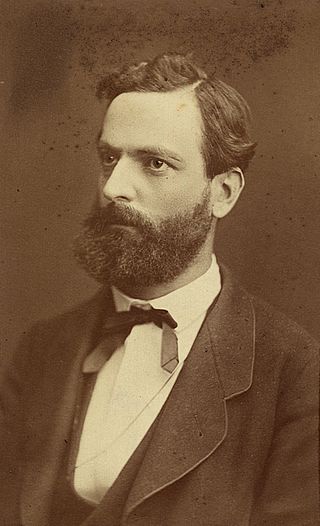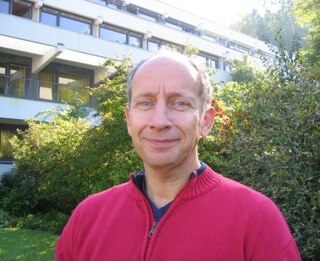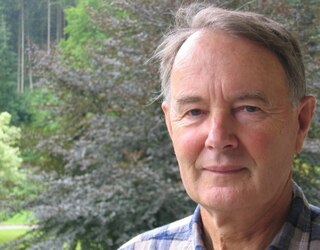
Norbert Schappacher (born 8 October 1950 in Essen) is a German mathematician and historian of mathematics. He was an Invited Speaker at the International Congress of Mathematicians in 2010 in Hyderabad. [1]

Norbert Schappacher (born 8 October 1950 in Essen) is a German mathematician and historian of mathematics. He was an Invited Speaker at the International Congress of Mathematicians in 2010 in Hyderabad. [1]
After secondary education at Essen's Burggymnasium, Schappacher studied from 1969 to 1971 at the University of Bonn, where he was taught by (among others) Günter Harder and Friedrich Hirzebruch. Schappacher obtained his Vordiplom in 1971 at the University of Göttingen, where he studied from 1971 to 1974 and was taught by (among others) Hans Grauert, Ulrich Stuhler, and Martin Kneser. For the academic year 1974–1975, Schappacher studied as an exchange student at the University of California, Berkeley, where his teachers included Tsit Yuen Lam and Robin Hartshorne. At the University of Göttingen, Schappacher received his Diplom in 1975 and from 1977 to 1986 held the position of assistant at the Göttingen Mathematical Institute. [2] There in 1978 he received his doctorate with advisor Martin Kneser and thesis Eine diophantische Invariante von Singularitäten über nichtarchimedischen Körpern (A diophantine invariant of singularities over non-Archimedean fields). [3]
He was from 1979 to 1981 at Paris-Sud University (University of Paris XI) in Orsay with John H. Coates and for the academic year 1983–1984 at the Max-Planck-Institut für Mathematik (MPI) in Bonn with Günter Harder. Schappacher in 1985 was an assistant professor (Professeur associé) at Paris-Sud University and habilitated in 1986 at the University of Göttingen with thesis Periods of Hecke operators. He was in 1986 at the Mathematical Sciences Research Institute (MSRI) in Berkeley, then worked in 1987 as an assistant professor in Orsay and was from 1987 to 1991 a Heisenberg fellow at the MPI in Bonn. He was at the Institute for Advanced Study for five months in 1990. [2]
Schappacher is since 1991 a professor at the University of Strasbourg. From 2002 to 2004 he was a visiting professor at TU Darmstadt and returned in 2004 to the University of Strasbourg. He has held visiting positions at several academic institutions, including the Isaac Newton Institute (for 2 months in 1997), Mumbai's Tata Institute of Fundamental Research (for 2 months in 2000–2001), and the Akademie der Wissenschaften zu Göttingen (as Gauss-Professor in summer 2007). In 2011–2012 he was a Fellow of Lichtenberg-Kolleg, Göttingen. [2]
Schappacher's research is primarily on number theory, arithmetic geometry, and the history of mathematics. He has done research on the history of mathematics in Germany during the era of National Socialism (including Edmund Landau, Oswald Teichmüller and the Mathematical Institute in Göttingen), as well as historical research on Kurt Heegner, Bartel Leendert van der Waerden, Diophantus of Alexandria, and Leonhard Euler. Since 2008 Schappacher is a member of the Euler Committee of the Swiss Academy of Sciences. He was from 2009 to 2016 editor-in-chief of the Revue d'histoire des mathématiques and is the managing editor of the Elemente der Mathematik . [2]
In 2011 he was elected a corresponding member of the Akademie der Wissenschaften zu Göttingen. [2]

Paul Julius Oswald Teichmüller was a German mathematician who made contributions to complex analysis. He introduced quasiconformal mappings and differential geometric methods into the study of Riemann surfaces. Teichmüller spaces are named after him. He was a supporter of the Nazi regime.

Friedrich Ernst Peter Hirzebruch ForMemRS was a German mathematician, working in the fields of topology, complex manifolds and algebraic geometry, and a leading figure in his generation. He has been described as "the most important mathematician in Germany of the postwar period."
zbMATHOpen, formerly Zentralblatt MATH, is a major reviewing service providing reviews and abstracts for articles in pure and applied mathematics, produced by the Berlin office of FIZ Karlsruhe – Leibniz Institute for Information Infrastructure GmbH. Editors are the European Mathematical Society, FIZ Karlsruhe, and the Heidelberg Academy of Sciences. zbMATH is distributed by Springer Science+Business Media. It uses the Mathematics Subject Classification codes for organising reviews by topic.

Felix Bernstein, was a German Jewish mathematician known for proving in 1896 the Schröder–Bernstein theorem, a central result in set theory, and less well known for demonstrating in 1924 the correct blood group inheritance pattern of multiple alleles at one locus through statistical analysis.

Heinrich Martin Weber was a German mathematician. Weber's main work was in algebra, number theory, and analysis. He is best known for his text Lehrbuch der Algebra published in 1895 and much of it is his original research in algebra and number theory. His work Theorie der algebraischen Functionen einer Veränderlichen established an algebraic foundation for Riemann surfaces, allowing a purely algebraic formulation of the Riemann–Roch theorem. Weber's research papers were numerous, most of them appearing in Crelle's Journal or Mathematische Annalen. He was the editor of Riemann's collected works.
Friedhelm Waldhausen is a German mathematician known for his work in algebraic topology. He made fundamental contributions in the fields of 3-manifolds and (algebraic) K-theory.

Wolfgang Lück is a German mathematician who is an internationally recognized expert in algebraic topology.
The German Mathematical Society is the main professional society of German mathematicians and represents German mathematics within the European Mathematical Society (EMS) and the International Mathematical Union (IMU). It was founded in 1890 in Bremen with the set theorist Georg Cantor as first president. Founding members included Georg Cantor, Felix Klein, Walther von Dyck, David Hilbert, Hermann Minkowski, Carl Runge, Rudolf Sturm, Hermann Schubert, and Heinrich Weber.

Matthias Kreck is a German mathematician who works in the areas of Algebraic Topology and Differential topology. From 1994 to 2002 he was director of the Oberwolfach Research Institute for Mathematics and from October 2006 to September 2011 he was the director of the Hausdorff Center for Mathematics at the University of Bonn, where he is currently a professor.

Egbert Valentin Brieskorn was a German mathematician who introduced Brieskorn spheres and the Brieskorn–Grothendieck resolution.

Albrecht Pfister is a German mathematician specializing in algebra and in particular quadratic forms.

Erika Pannwitz was a German mathematician who worked in the area of geometric topology. During World War II, Pannwitz worked as a cryptanalyst in the Department of Signal Intelligence Agency of the German Foreign Office colloquially known as Pers Z S. After the war, she became editor-in-chief of Zentralblatt MATH.

Günter Harder is a German mathematician, specializing in arithmetic geometry and number theory.
Werner Weber was a German mathematician. He was one of the Noether boys, the doctoral students of Emmy Noether. Considered scientifically gifted but a modest mathematician, he was also an extreme Nazi, who would later take part in driving Jewish mathematicians out of the University of Göttingen.

Joachim Schwermer is a German mathematician, specializing in number theory.
Erhard Scholz is a German historian of mathematics with interests in the history of mathematics in the 19th and 20th centuries, historical perspective on the philosophy of mathematics and science, and Hermann Weyl's geometrical methods applied to gravitational theory.

Siegmund Dieter Puppe was a German mathematician who worked in algebraic topology, differential topology and homological algebra. He is known for the Puppe sequence in algebraic topology.

Winfried Scharlau was a German mathematician.
Johann Jakob Burckhardt was a Swiss mathematician and crystallographer. He was an invited speaker at the International Congress of Mathematicians in 1936 in Oslo.

Günther Hans Frei is a Swiss mathematician and historian of mathematics.